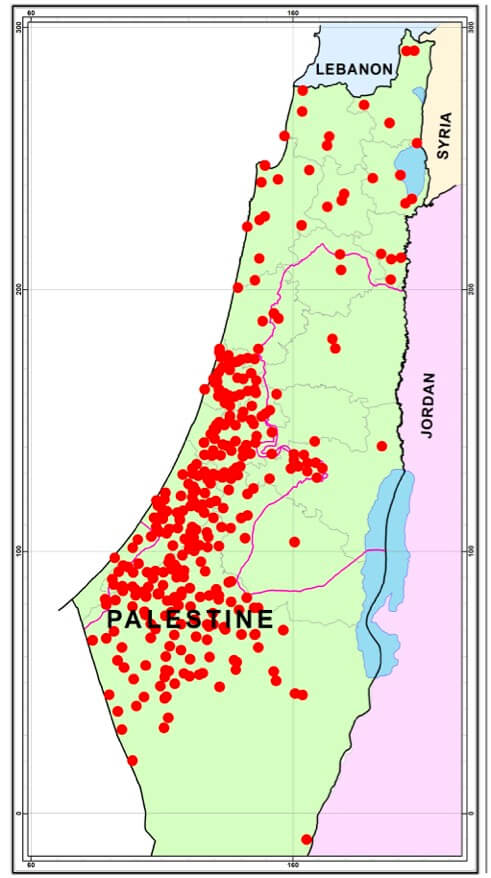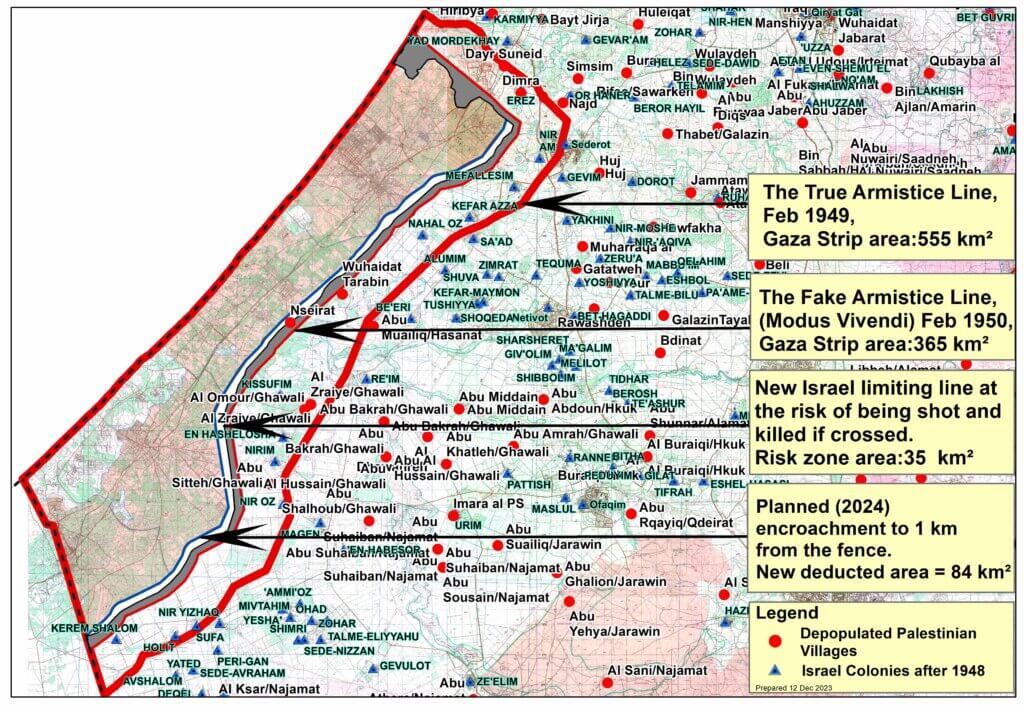Yes, I could have been one of those who broke through the fence had I been much younger and was still living in the concentration camp called the Gaza Strip.
My story is the same as all of them. On May 14, 1948, my family on our land, “Ma’in Abu Sitta,” was attacked by a Haganah force of 24 armored vehicles. The force destroyed and burnt everything. The soldiers demolished the school that my father built in 1920; they stole the motor and equipment in the flour mill and well pump; they killed anyone in sight.
On that day, when Ben-Gurion announced his state, I became a refugee. We were pushed into the prison compound called the Gaza Strip, 4 kilometers away from my home.
I was not alone. Palestinians living in 247 towns and villages in southern Palestine were driven to this enclave by dozens of massacres, such as in Bureir, Abu Shusha, Ed Dawayima, and many others. The tiny Gaza Strip, only 1.3% of Palestine, became a temporary home for 2.3 million Palestinian refugees. The Israeli attacks against them, by land, air, and sea, and with a complete siege, never stopped for 75 years.
I went to school in Egypt, but my cousins never wavered to cross the barbed wire called the Armistice Line and tried to return home, in the same manner of October 7. They crossed the barbed wire and attacked the occupiers of our land. They retrieved an elderly relative who remained, they watered the remaining cattle, and they generally tried to restore life to Ma’in Abu Sitta, our land.
I can never forget my cousin, Hassan Madi, with his smiling face and pleasant demeanor. He used to come back to tell us what happened to our groves and what the settlers did to our place. He was a very brave fida’i. He used to sneak into the settlers’ camp and listen to them talk. He was killed by a mine buried on his route.
Fifteen other young people from my family were killed in the couple of years after 1948. In the period from 1948 to 1956, an estimated 5,000 Palestinians were killed trying to return home.
The settlers set up prefab units on my land, which developed into Kibbutzim. Their names are current in the media nowadays. Nirim was built on my father’s land. I was born a few meters away from the Kibbutz site. Ein Hashlosha Kibbutz, a few kilometers to the north, is built on land that belonged to my father and his cousins, a huge wheat and barley field. Nir Oz was built on the land of my father’s uncle, Haj Mahmoud. His son Hamed, a civil engineer, devoted his life to the liberation of Palestine and was a key actor in forming the PLO in 1964, remaining in its executive committee for over 40 years. The fourth kibbutz on our land was named Magen. This is the site of Sheikh Nuran, a venerated site where women sought blessings for their newborns. This was the ancient site of St. Hilarion, a key figure in Christian Palestine. The site was his worshipping retreat in fourth-century Byzantine Palestine.
Today, when you hear the names of these kibbutzim, you must recall on whose land they were built. You must remember that the owners of this land have never given up their right to return home.
 MAP 1: ORIGIN OF REFUGEES IN THE GAZA STRIP
MAP 1: ORIGIN OF REFUGEES IN THE GAZA STRIP
This applies to over two million Palestinians in the Gaza Strip. When you hear talk about the hostages, remember they are the true hostages for over 27,000 days. They came from 247 towns and villages in southern and central Palestine. See Map 1 for the origin of Gaza refugees. They are crowded in camps at a density of 8,000 persons/km2.
Not only were they expelled and made refugees in 1948, but they were constantly attacked in camps in exile in 1953, 1956, 1967, 1971, and 1987, and with fierce regularity since 2006 up until today. In a twist unknown in colonial history, their ethnic cleansing has been upgraded in 2023 to a genocide of unparalleled proportions. The extent of its ferocity, the number of women and children killed, the vast areas of destruction, and the number of dropped bombs on such a tiny place in less than three months exceeds anything known in two world wars.
The Gaza Strip is bound by the Armistice Agreement signed between Egypt and Israel on February 24, 1949. See Map 2 of Gaza’s armistice line below. Article 2 of the Agreement states that the Line does not confer or deny rights to the warring parties. It is merely the line at which warring parties stopped on that date.
 MAP 2: GAZA ARMISTICE LINES
MAP 2: GAZA ARMISTICE LINES
Israel has no borders, neither by its own admission nor by any article in international law. In 1948, Israel occupied 20,500 km2 (80% of Palestine), of which only 6% was obtained through the collusion of the British Mandate. The rest was obtained just by military force.
One year after the official Armistice Agreement in February 1950, Israel complained that many refugees had crossed the line and suggested to Egypt that to avoid clashes, it should establish a temporary line called modus vivendi, provided that the original agreement remains in force. This reduced the area of the Gaza Strip from 555 km2 to the present 365 km2. As Map 2 shows, this temporary line became unofficially the regular line shown in maps and maintained by Israel.
There is a macabre element in this fact. Many of the attacked kibbutzim, Nirim, Nir Oz, and Ein Hashlosha, that were built on my and others’ land, actually fall within the Gaza Strip proper, as Map 2 clearly shows.
Israel has relentlessly tried to chew more and more of the Gaza Strip as a “buffer zone.” No international body ever contested Israel’s continued reduction of the tiny Gaza Strip.
Meanwhile, the war against those young people who crossed the line to return home continues. They have to contend with falling bombs in Gaza and a relentless smear campaign abroad.
The false information and ugly defamation attributed to them, like beheading babies and a campaign of raping women, have turned out to be entirely false, but its effect lingers on. Anyone who knows them in Gaza knows they have a strict moral code.
Nothing can hide the determination and courage of those young people. They have stood fast for 90 days, longer than in any Israeli war with its neighbors.
When the dust settles down, if it does, history will show who heroically defended his homeland and who, on the other hand, committed so many heinous crimes. This memory will chart the history of both peoples.